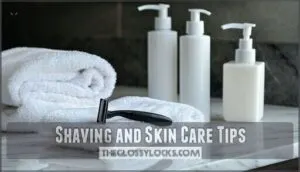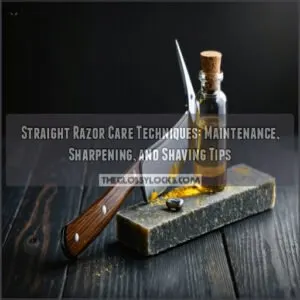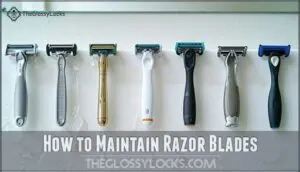This site is supported by our readers. We may earn a commission, at no cost to you, if you purchase through links.

After each shave, rinse the razor with warm water to remove hair and cream, then dry it thoroughly with a soft cloth—rust never sleeps.
For extra cleanliness, use a drop of mild soap or a splash of isopropyl alcohol.
If you’re aiming for longevity, a thin coat of blade oil helps ward off rust.
Store your razor in a dry spot, away from bathroom humidity, to keep it in top shape.
Master these habits, and your razor will serve you faithfully—there’s more to blade care than meets the eye, and following these steps will help you maintain a sharp blade.
Table Of Contents
- Key Takeaways
- Razor Maintenance Basics
- Cleaning and Hygiene Practices
- Storage and Safety Precautions
- Shaving and Skin Care Tips
- Daily Shaving Routine Optimization
- Frequently Asked Questions (FAQs)
- How to properly shave every day?
- What is the proper way to care for a razor?
- What should be my shaving routine?
- Is it okay to use razor every day?
- How to travel safely with a straight razor?
- What to do if the razor handle loosens?
- Can razors be shared between family members?
- How to dispose of old or damaged blades?
- Are there eco-friendly alternatives for razor care products?
- Conclusion
Key Takeaways
- Rinse and dry your razor after every shave to prevent rust and keep your blade sharp.
- Store your razor in a dry, ventilated spot and apply a thin coat of blade oil for extra protection.
- Strop your razor daily with light pressure to maintain edge alignment and only hone every few months as needed.
- Don’t share razors, and always clean and disinfect the blade to avoid skin irritation and infection.
Razor Maintenance Basics
You’ll start by learning the basics of razor maintenance, which is essential for extending the life of your razor and getting a smooth shave.
By following a daily care routine, you’ll be able to keep your razor in great condition, and it will continue to serve you well, providing you with a comfortable and close shave every time.
A little daily care goes a long way—your razor will reward you with a smoother, more comfortable shave each time.
Daily Stropping Techniques
You’ll master daily stropping techniques by using a leather strop, applying minimal stropping pressure, and maintaining proper blade alignment.
Stropping frequency and direction are key to razor care, ensuring a sharp shaving tool with each stroke, typically 15-30 passes, for ideal results and safety.
To keep your straight razor in top condition, consider regular stropping’s importance for proper maintenance.
Honing Frequency and Methods
In the matter of keeping your razor sharp, don’t overdo it—honing frequency matters.
Most folks can get by with honing every few months, depending on use.
Pick the right whetstone for your setup, focus on proper honing angles and blade geometry, and always strop after honing.
Regular stropping helps maintain the blade’s sharp edge between honings.
For tough cases, trust professional honing or advanced razor sharpening methods.
Blade Angle and Sharpening
Perfect blade geometry starts with understanding honing angle fundamentals. Straight razors require 7-8 degree angles, using the blade’s back as your guide.
Blade geometry is all about the angle—keep your straight razor at 7-8 degrees for a sharper, safer shave.
Most razors feature 16-19 degree bevel angles naturally. For razor sharpening, choose whetstone grits of 1000 or finer—water stones excel at maintaining these precise angles.
Smaller angles create sharper edges while larger angles boost durability. Proper sharpening techniques preserve blade geometry.
Regular stropping helps to smooth impurities and burrs and is essential for maintaining the blade geometry.
Strop Tension and Pressure
Setting up proper strop tension prevents blade damage while maintaining sharp edges.
Too much pressure dulls your razor, while too little won’t realign the edge geometry effectively.
- Hold steady tension – Keep consistent pressure throughout each stroke
- Use light touch – Apply minimal force to avoid damaging blade alignment
- Check leather strop – Verify proper tautness for ideal stropping force
- Maintain angle – Keep razor geometry consistent during tension consistency impact
- Avoid over-pressure – Strop material effects change with excessive force
Cleaning and Hygiene Practices
You’ll keep your razor performing at its best when you maintain proper cleaning habits after each shave.
Clean blades last longer and also provide smoother, safer shaves while preventing skin irritation and infection.
Daily Rinsing and Drying
After proper maintenance, daily cleaning starts with rinsing your razor under warm water temperature to remove hair and soap residue.
Choose gentle soap selection for thorough cleaning without damaging the blade. Pat dry with lint-free drying cloths using proper drying techniques.
To further disinfect, consider soaking in rubbing alcohol.
This daily cleaning routine prevents residue buildup and maintains rust avoidance, keeping razor hygiene at its best between shaves, ensuring proper maintenance and daily cleaning.
Sanitizing With Isopropyl Alcohol
For an extra layer of hygiene, consider razor sanitizing with isopropyl alcohol. It’s a straightforward way to reduce bacteria.
After rinsing, disinfect the blade by soaking it in 70% isopropyl alcohol. Remember, immersion time should be about 5-10 minutes.
You can find an isopropyl alcohol razor online.
- Address residue concerns with a q-tip.
- Monitor alcohol concentration.
- Consider alternative sanitizers.
- Watch for skin irritation.
- Explore other disinfectant options for blade sanitization.
Weekly Deep Cleaning Methods
You perform a weekly deep clean using a soft toothbrush and disinfectant soaking.
| Method | Tool | Frequency |
|---|---|---|
| Disassemble | Soft toothbrush | Weekly |
| Soak | Barbicide | Weekly |
| Rinse | Warm water | Weekly |
Removing Buildup and Residue
You remove residue by identifying buildup, using mild soap and isopropyl alcohol as cleaning solutions.
Tool selection is key in deep cleaning, preventing debris accumulation in your razor cleaning routine, ensuring a clean and hygienic shave.
Regular cleaning helps prevent residue and extends razor lifespan.
Storage and Safety Precautions
You’ll want to store your razor in a dry place to prevent rust and damage.
By following proper storage and safety precautions, you can keep your razor in great condition and guarantee it continues to perform well.
Dry Storage Methods and Materials
You’ll want to store your razor in a dry place, like a wooden box, to prevent rust.
Material breathability is key, so consider storage methods that allow for airflow, ensuring longterm razor care and rust prevention through proper drying and storage solutions.
To further protect the blade, consider methods to prevent rust and corrosion to ensure proper care.
Applying Blade Oil and Protection
After securing dry storage, blade oil becomes your razor’s best friend against rust and corrosion.
Apply a thin layer of mineral oil using gentle strokes with a soft cloth. Clean blades thoroughly before oiling to prevent trapping moisture or debris.
Lightweight oils like camellia distribute easily, while thicker options may need gentle warming.
Regular application maintains that protective barrier.
Avoiding Humid Environments and Damage
Beyond protecting your razor with oil, humidity becomes your blade’s biggest enemy.
Moisture accelerates corrosion and damages razor alignment faster than you’d think. Smart storage choices protect your investment and maintain peak performance.
- Rust Prevention starts with keeping razors away from steamy bathrooms
- Safe Handling means never storing wet blades in closed containers
- Travel Storage requires breathable cases that prevent moisture buildup
- Protective Cases with ventilation holes guard against humid conditions
- Temperature Control prevents condensation that leads to blade damage
Regular Inspection and Maintenance
Keeping your razor in top shape means regular inspection and maintenance, not just stashing it somewhere dry.
Make sharpness checks part of your razor maintenance routine. Look for rust, test handle security, and don’t skip pivot lubrication.
Spotting trouble early—like nicks or loose parts—makes damage troubleshooting easier. Consistent razor inspection, blade maintenance, and razor cleaning keep your shave smooth and your razor lasting longer.
Shaving and Skin Care Tips
Getting a smooth, comfortable shave starts with the right skin care routine and smart product choices.
You’ll protect your skin and keep your razor in top shape by following a few simple tips every day.
Pre-Shave Cleansing and Exfoliation
A solid preshave prep starts with facial cleansing—wash your face to remove oil and dirt.
Next, try gentle exfoliation methods, like a scrub or chemical exfoliant, to lift dead skin.
Match your skin preparation to your skin type for best results, as smart product selection boosts routine effectiveness, and proper skin cleansing and exfoliating pave the way for a smoother, safer shave.
Using pre-shave oil can further soften the hair, which is an important part of a pre-shave routine.
Moisturizing and Skin Type Considerations
What’s your skin type? Your moisturizer choice depends on it.
Dry skin needs rich creams with glycerin and dimethicone to lock in skin moisture.
Oily skin benefits from lightweight gels that won’t clog pores.
Combination skin requires targeted Post-Shave Balm – thicker for dry areas, lighter for oily zones.
Sensitive Skin Care demands hypoallergenic formulas without harsh ingredients, which is crucial for dry skin needs.
Shaving Cream and Oil Selection
Quality shaving cream and preshave oil make all the difference in your daily routine.
Look for natural shaving cream with glycerin for rich lather quality, while coconut and jojoba oils provide excellent oil benefits.
Those with sensitive skin should choose alcohol-free formulas containing aloe vera.
Your scent preferences matter too—sandalwood and eucalyptus offer soothing properties that enhance the experience.
Reducing Friction and Irritation
While maintaining proper shaving angles and lather quality prevents most friction, your razor’s blade sharpness and post-shave care routines matter equally.
Fresh razor blades combined with adequate skin hydration create the foundation for irritation-free shaving.
- Pre-shave prep – Warm water opens pores and softens whiskers
- Quality shaving cream – Creates protective barrier between blade and skin
- Light pressure – Let the razor’s weight do the work during your shaving routine
- Gentle strokes – Avoid aggressive passes that increase skin irritation
Daily Shaving Routine Optimization
You can transform your daily shave from a rushed chore into a smooth, satisfying ritual with the right approach.
Consistency and proper technique will help you achieve better results while protecting your skin and extending your razor’s life, which is a key part of a satisfying ritual.
Creating a Consistent Shaving Schedule
Establishing a consistent shaving frequency transforms your grooming from chaotic to controlled.
Most men benefit from daily shaving, while others prefer every other day based on skin sensitivity. Choose your ideal time of day – morning shavers enjoy smoother starts, evening shavers wake up refreshed.
| Shaving Frequency | Best Time of Day |
|---|---|
| Daily | Morning (6-8 AM) |
| Every Other Day | Evening (6-8 PM) |
| 3x Per Week | Flexible Schedule |
Schedule adherence and routine integration create lasting habits that enhance your daily shaving routine.
Choosing The Right Razor and Blade
Once your schedule’s set, picking the right tools makes all the difference.
Consider these five steps for smooth sailing:
- Match Razor Types to your shave style.
- Choose premium steel blades for razor durability.
- Check handle ergonomics for comfort.
- Factor in skin sensitivity before you buy.
- Replace razor blades often—razor blade care pays off.
These steps are crucial for ensuring a comfortable and effective shaving experience, and by following them, you can enjoy smooth sailing with your shaving routine.
Adjusting Water Temperature and Pressure
Once you’ve picked the right blade, focus on water temperature and pressure.
The ideal temperature—warm, not scalding—softens whiskers and boosts razor blade care.
Light, steady pressure protects skin sensitivity and prevents nicks.
Water softeners help if you’ve got hard water, making razor cleaning easier.
Fine-tune your technique; small changes can make a big impact on your shaving routine.
Minimizing Razor Burn and Ingrown Hairs
Ever wonder why razor burn and ingrown hairs keep coming back? It’s all about your shaving technique and routine.
Stick to these shaving tips for irritation-free shaves:
- Exfoliate gently, but not too often—balance is key for Exfoliation Frequency.
- Use sharp blades to boost Blade Sharpness.
- Apply soothing Aftershave Balms.
- Treat bumps promptly with Ingrown Hair Treatment for quick razor burn treatment.
Frequently Asked Questions (FAQs)
How to properly shave every day?
Smooth skin isn’t just luck—it’s your technique.
Cleanse and exfoliate first, then lather up.
Use light strokes, go with the grain, rinse often, and finish with moisturizer.
Sharp blades and gentle hands win the day.
What is the proper way to care for a razor?
Rinse your razor with warm water after each use, dry it thoroughly, and store it in a dry spot.
Oil the blade weekly, check for rust or nicks, and strop regularly—your razor will thank you.
What should be my shaving routine?
Start by cleansing and exfoliating your face, then lather up with a quality brush.
Shave with light pressure, following the grain.
Rinse, pat dry, apply moisturizer, and finish with an alum block for a soothing touch.
Is it okay to use razor every day?
Like a trusty companion, your razor can work daily if you treat it right.
Strop before each shave, rinse thoroughly afterward, and dry completely to prevent rust.
Daily use won’t harm a well-maintained blade.
How to travel safely with a straight razor?
Pack your straight razor in checked luggage only—it’s prohibited in carry-on bags.
Use a protective case or leather pouch to prevent blade damage.
Make certain it’s completely dry and lightly oiled before packing to avoid rust during travel.
What to do if the razor handle loosens?
Check the pivot mechanism for looseness and tighten the pin carefully. If it’s substantially loose, apply a small drop of thread locker or seek professional repair to prevent damage.
Can razors be shared between family members?
Sharing razors is like passing around a toothbrush—it’s a hygiene minefield.
Don’t share razors between family members due to infection risks, blood-borne pathogens, and cross-contamination concerns.
Each person needs their own razor to prevent these infection risks.
How to dispose of old or damaged blades?
Wrap old blades in heavy paper or cardboard before throwing them away.
Never toss loose blades in regular trash since they’ll cut sanitation workers.
Some pharmacies accept used blades for safe disposal.
Are there eco-friendly alternatives for razor care products?
You can use natural alternatives like coconut oil for blade lubrication, castile soap for cleaning, and homemade leather strops from vegetable-tanned leather for eco-friendly razor maintenance.
Conclusion
Studies show that a well-maintained razor blade can last 5-10 times longer than a neglected one.
Your daily razor care routine doesn’t end when you finish shaving—it’s what happens next that counts.
Following proper cleaning, drying, and storage steps transforms blade maintenance from a chore into habit. You’ll save money, reduce irritation, and enjoy smoother shaves.
Remember, consistent care beats expensive replacements every time. Start tomorrow morning and watch your razor reward your efforts with smoother shaves.
- https://www.gillettevenus.com/en-us/womens-shaving-guide/how-to-shave/how-to-clean-a-razor/
- https://estrid.com/blogs/shaving-tricks/guide-to-keeping-your-razor-clean
- https://www.reddit.com/r/wicked_edge/comments/47py43/beginners_tips_care_and_maintenance_of_shaving/
- https://www.elegantgbarbershop.com/12-quick-tips-for-maintaining-your-razor-and-shaving-gear/
- https://www.therazorcompany.com/blogs/the-benefits-of-wet-shaving/razor-blade-care-101-how-to-extend-the-life-of-your-blades













